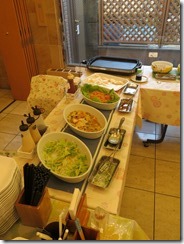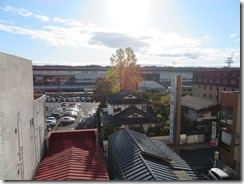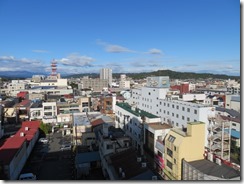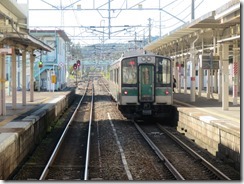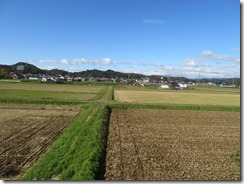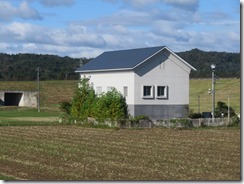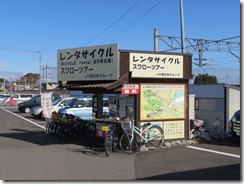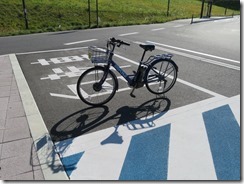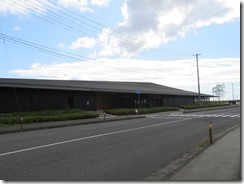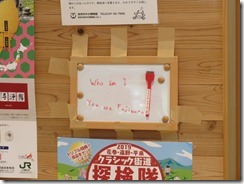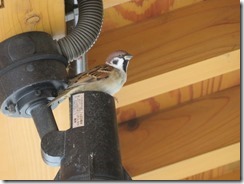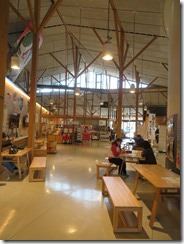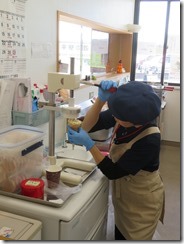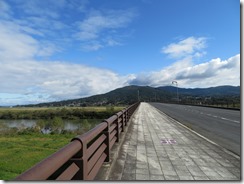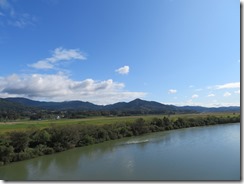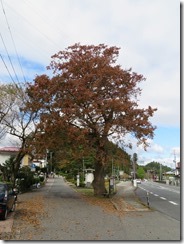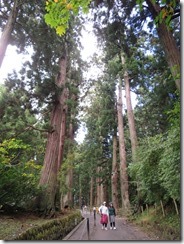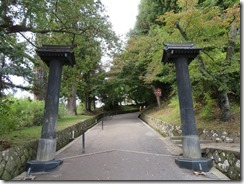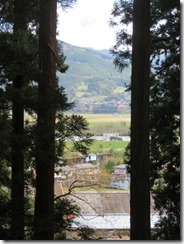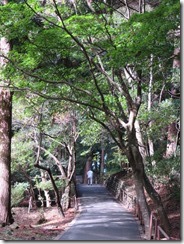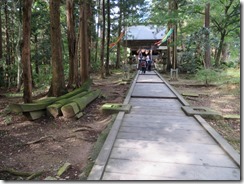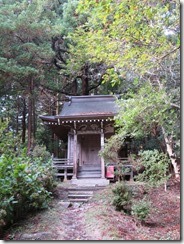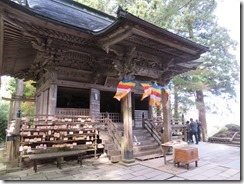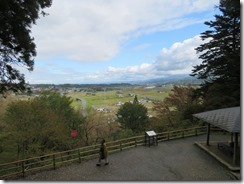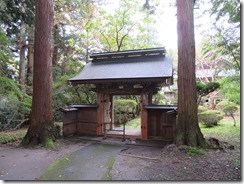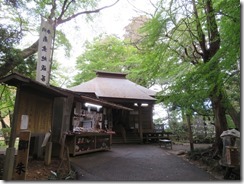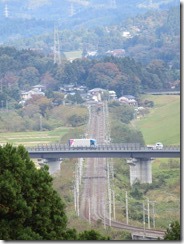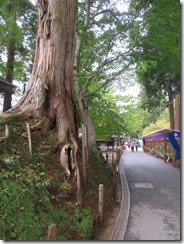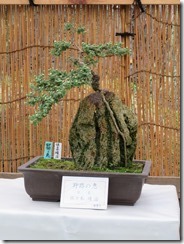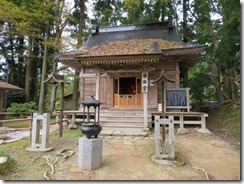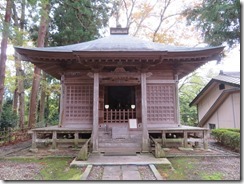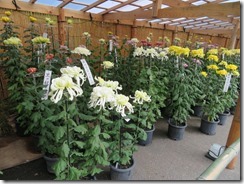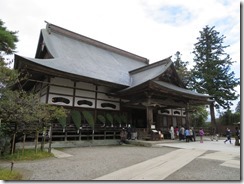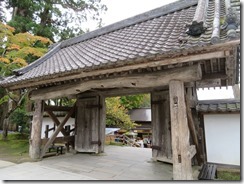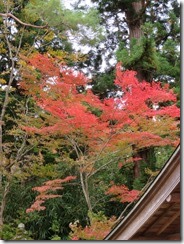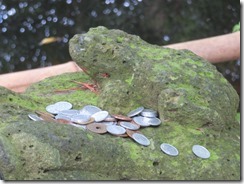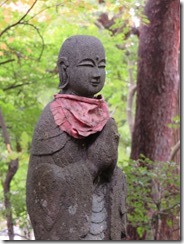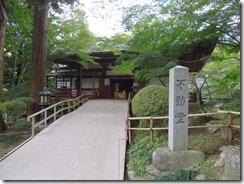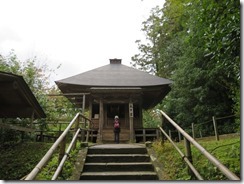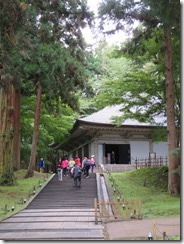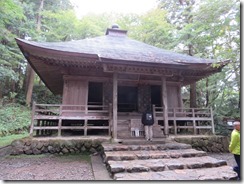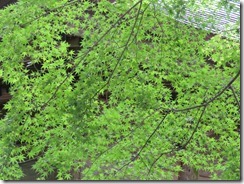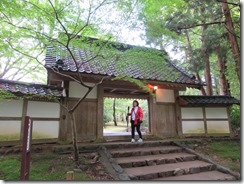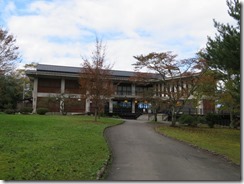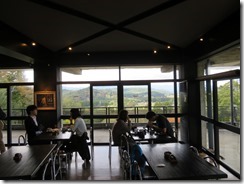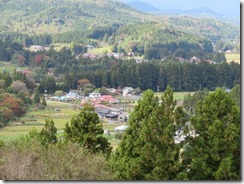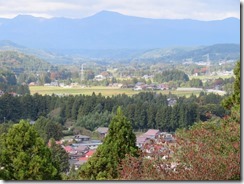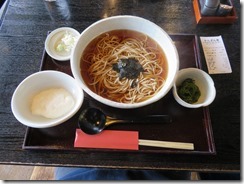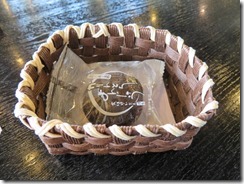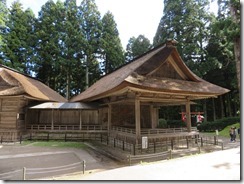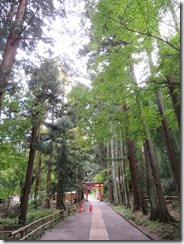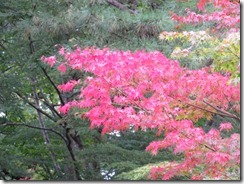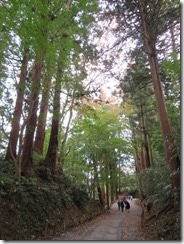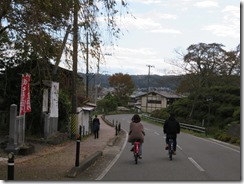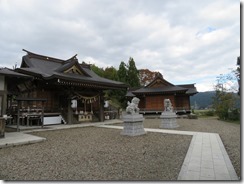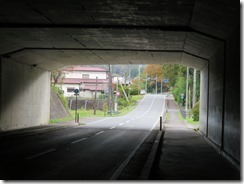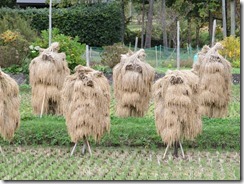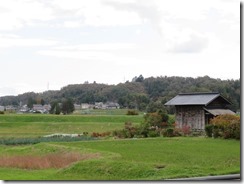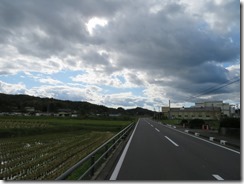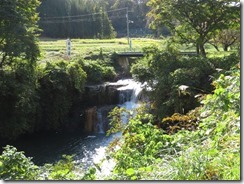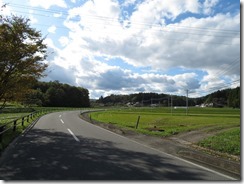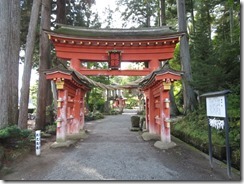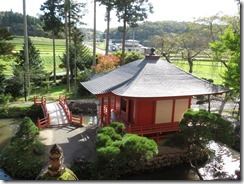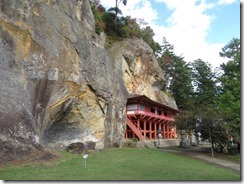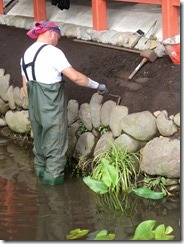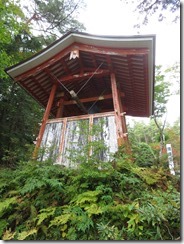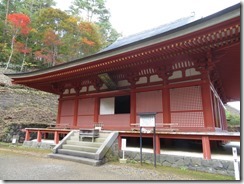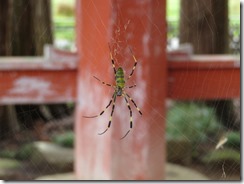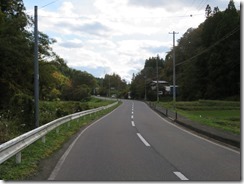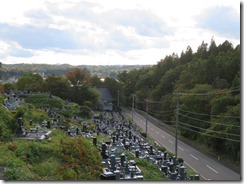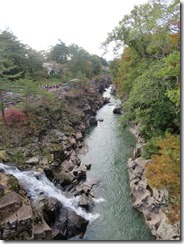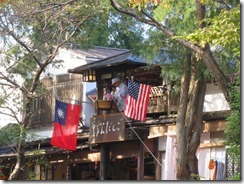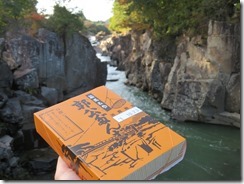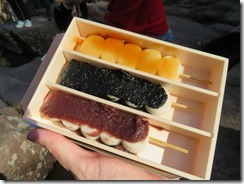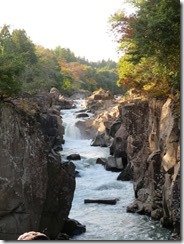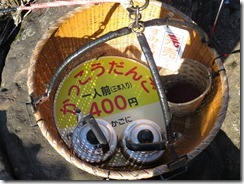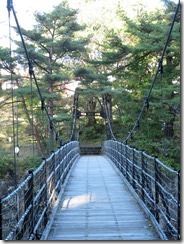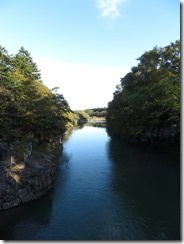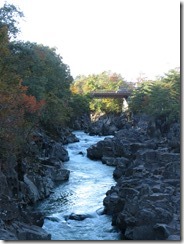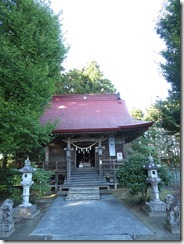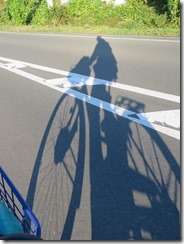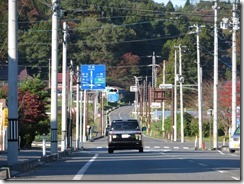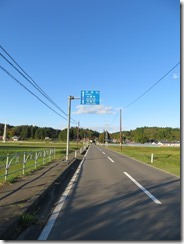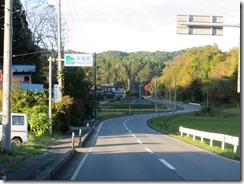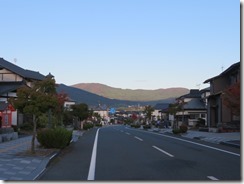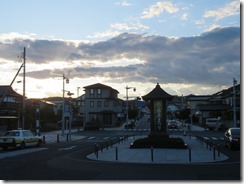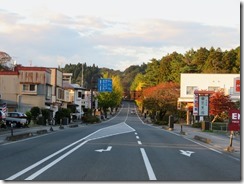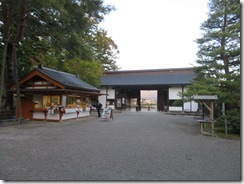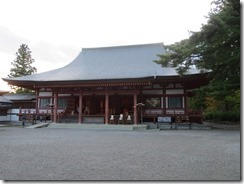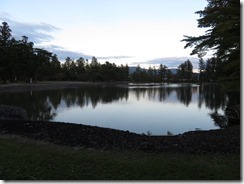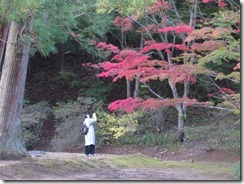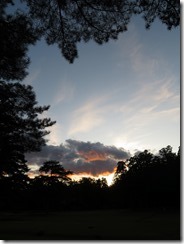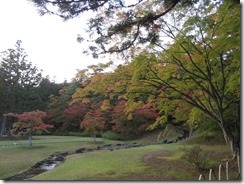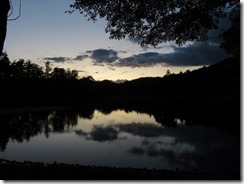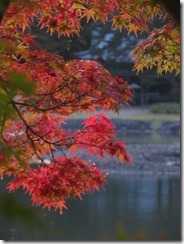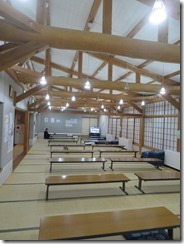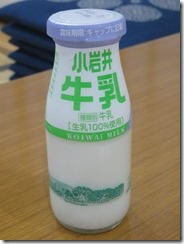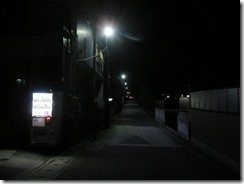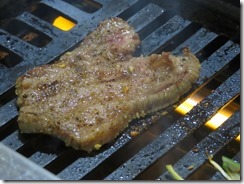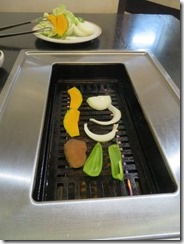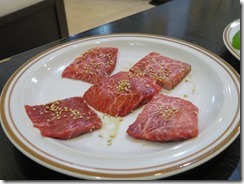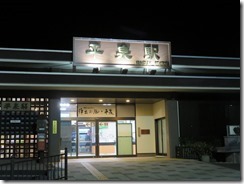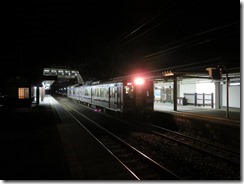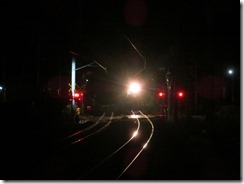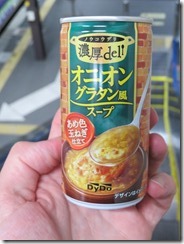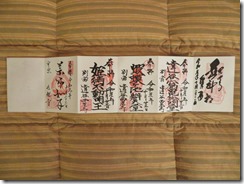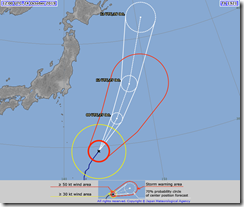There was an article in the Sydney Morning Herald the other day about flood prevention methods in Japan. The government has built levees and floodgates and overflow channels and whatnot everywhere, designed to withstand a hundred-year storm, and possibly spending more than they can afford to do so… and last Saturday, around the region, several of them failed. Experts are suggesting that with the way the climate is going, it might be necessary to upgrade the defences to withstand thousand-year storms… but it might actually be more cost-effective to simply educate people to evacuate to higher ground faster instead.
Today, more breakfast. The mochi wasn’t on offer today, but there was some Napolitan pasta…
So, Ichinoseki is the furthest south, and second largest, city in Iwate Prefecture, part of the Tohoku Region. Iwate is actually the second-largest prefecture in Japan, after Hokkaido, though Hokkaido is so much larger than Iwate that it barely counts (actually, Hokkaido is more than twice as much larger than Iwate than Alaska is than Texas… if that makes sense. What I’m saying is that if Alaska is X times bigger than Texas, then Hokkaido is more than 2X times bigger than Iwate… actually, it’s 2.2X). It’s also got the second-lowest population density, after Hokkaido. Back in ye olden times, Ichinoseki marked the northern edge of Japanese territory (the name means “first barrier”) – everything further north belonged to the native Emishi people, who were largely wiped out as an independent nation after the year 802, being incorporated into the newly unified Yamato nation as the “Northern Fujiwara” clan.
Today, though, I headed to the neighbouring town of Hiraizumi. It was once the capital of the Northern Fujiwara territory of Oshu, which comprised almost a third of the land area of Japan, and town at its peak rivalled the capital of Kyoto in size. The town was destroyed in 1189, and the Fujiwara clan fell not too long after. When the haiku master Matsuo Basho visited in 1689, he wrote the following haiku after what he saw:
Ah, summer grasses!
All that remains
Of the warriors’ dreams.
Which, honestly, kinda reminds me of a Japanese haiku version of Percy Shelly’s sonnet Ozymandias (“Look upon my works, ye mighty, and despair”). Today, Hiraizumi is mostly known for the UNESCO heritage-listed “Historic Monuments and Sites of Hiraizumi”, which is what I came here today to see. (Actually, my original plan for this day was to head further north to the town of Hanamaki, birthplace of author Miyazawa Kenji, and since the sightseeing spots there are quite separated, and there’s basically no public transport that I could find, I was planning to rent a car and drive there, the first time I’d rent a car in Japan. In the end, though, I decided it was a bit silly to go all that way when there were places I wanted to visit nearer Ichinoseki, even though it’d let me visit some Michi no Eki en route.)
Absolutely lovely weather today. Someone recently told me that there’s always nice weather after a typhoon, and Neoguri has disappeared from the JMA forecast, so clearly he’s puttered out somewhere, taking the weather with him. I even decided to leave my umbrella at home. Before leaving the hotel, I headed up to the eighth floor to take some photos from the fire stairs – not the highest floor of the hotel, but I’m fairly sure it’s the highest one with the door to the fire stairs unlocked. Very nice view. Because of my short sightseeing day yesterday, I didn’t need to change my camera battery, and decided not to do a just-in-case charge last night. I paid for that this morning by having my first battery run flat almost immediately…
So, I hopped on the train. It’s two stops up the Tohoku Main Line from Ichinoseki, and I made sure when I was at the station yesterday to confirm that I could actually use my Suica card at Hiraizumi, and I could – no repeating my error from yesterday. At Hiraizumi, instead of renting a car, I rented a bicycle – my first time renting a bike in Japan. My sightseeing spots are a little way apart, and I got the impression from Google that buses are… infrequent, so I decided I’d rent the bike to speed things up. Even decided to splurge for the electrically-assisted bicycle.
Hopped on and started pedalling up the road with the greatest of ease. First stop: there’s a Michi no Eki in Hiraizumi, not too far out of my way, so I went there. Pretty nice building. And there seemed to be a film crew filming something in the shop there. Also, there were stamps there as part of a Michi no Eki stamp rally, and they had gold ink. Gold! So pretty. And also a small booth selling local ice cream flavours – I decided to get Japanese mustard flavour, and… that may have been a bit of a mistake. It was quite a bit more bitey than I had been anticipating. Quite possibly that would be the actual mustard seeds embedded in the ice cream.
Took a brief detour up to the highway atop the embankment behind the Michi no Eki to see what I could see, and it was quite pretty, though a tad difficult to encompass in the camera’s view.
Then I rode back down and headed for my first main stop, the temple of Chuson-ji. En route, I found them re-doing the centre of the road with pavers… not all the way across, though. Anyway, Chuson-ji is said to have been founded in the year 850 by Ennin, a priest of Enryaku-ji in Kyoto, but other evidence suggests it was founded instead (or possibly it was re-founded) by Fujiwara no Kiyohara (who also founded the Northern Fujiwara clan) in 1095. With halls running up the side of Mount Kanzan, it’s the head temple of the Tendai sect of Buddhism for the Tohoku Region.
Parked the bike in a free bike parking area I came across, then headed into the temple. It was an pretty steep walk up from the main gate up to the first hall, but at extremely picturesque one. Turns out there’s a whole heap of different halls before reaching the main hall – a Hachiman hall, then a Benkei hall, then a Jizo hall, then a Kannon hall, and so on and so forth. The temple was also holding a chrysanthemum festival, displaying chrysanthemums grown by all of the local flower-growing associations, and even some from a local elementary school. There was a display of bonsai trees too, which I was quite impressed by. (Side note, there’s a big autumn festival here too… which starts the very day I leave Japan.)
The main hall was pretty impressive, but admittedly nothing particularly special – though for some reason, it had a statue of of a literal white elephant inside, made from what appeared to be papier-mâché. Sadly, noone talked about the elephant in the room. No photos allowed inside, as is typical.
No, the main drawcard here is further up the hill, past several more smaller halls – Konjiki-do, the gold-coloured hall. It’s a hall covered entirely in gold leaf, right from the tip of the ornament on the roof’s peak to the footings of the support pillars. It’s inside another building to protect it from the elements, and while the rest of the temple is free, entry to see the Konjiki-do costs money (though you also get access to the temple’s treasures museum with the same ticket). Sadly, no photos are allowed inside… but for some reason, temples of the outer building are often featured in tourism images for Iwate Prefecture – for example, the first image on the Wikipedia article for Hiraizumi. The hall is apparently the first structure in Japan to be declared a Japanese National Treasure. For a brief moment at this point, it actually tried to rain, but it quickly reconsidered.
At the top of the temple was a restaurant named Kanzan-tei, so I decided to go have lunch there. I had soba noodles in soup with tororo (grated nagaimo, Chinese yam, which has the curious property that it turns into a slimy paste when grated finely). I was also given a little thing which I’d taken to be red bean paste, but which turned out to be a small chocolate cake-like thing… filled with red bean paste. I confess, I’m getting a little bit tired of soba and udon, but it’s largely what seems to be available in places like this. Spectacular view from the windows, though. The minimum rental period for the bikes is four hours, so I’d set an alarm for three hours to judge how much progress I was making, and it went off while I was eating lunch – and I was still at my first sightseeing spot.
So, I decided I should zip back down to the bike and head to my next spot, probably. First, though, I went to visit Hakusan Shrine, which was next door. It’s thought to have been the first building constructed in the area – a writer in 1334 recorded that the shrine was already seven hundred years old. (The building itself is not, mind – it’s been rebuilt several times.) It’s also got an extensive noh stage.
Walked briskly back down to my bike. It was a nice temple, but I had to dodge busloads of Chinese tourists the entire time, except for Kanzan-tei and Hakusan Shrine. It was especially bad inside the Konjiki-do building. Back at the bike, I decided to skip stop number two, as it’s within an easy walk of the train station, and head for stop number three.
Stop number three was not within easy walk of the train station, hence the rental of the bicycle. Specifically, it’s 6.7 kilometres down Prefectural Highway 31. For some reason, I kind of imagined that the ride between sightseeing spots would be, like, unremarkable featureless forest, or something, but actually it was broad open countryside, alongside a river, covered with rice paddies with houses scattered here and there, and I had to constantly tell myself not to stop every five metres to take photos. Downside of the electric bike, though, is that while it’s real easy to start off and get to full speed, they’ve got no gears, so staying at full speed requires constant furious pedalling. (Well, specifically, the motor has three gears to assist in hill climbing, but the pedals don’t.)
About a half-hour later, I reached my next stop: Takkoku-no-Iwaya, a temple to Bishamonten. Designed after the stage at Kiyomizu-dera in Kyoto, it’s built underneath a rock overhang, so it looks quite spectacular. The temple was founded in the year 801, but the current building dates from 1961. There’s also a hall dedicated to Benzaiten on an island in a pond in front, and a hall to Fudo slightly behind – which had plants growing all over the thatched roof – and even its own Kondo (gold hall) though this wasn’t covered in gold leaf. Curiously, the temple had three torii gates at the entrance, which is usually indicative of Shinto shrines. The temple was nominated to be included as part of the Hiraizumi UNESCO listing, but it was turned down for reasons I don’t entirely understand – they’re still working to get it accepted.
Departed for the next stop, another 3.2 kilometres away down the road, up and over a small mountain – and on the way down, there was a fairly nice view over a temple from the top of its graveyard. I also discovered the bike’s regenerative braking charges the battery if you’re coasting above a certain speed, but said speed was almost terrifyingly fast, and I only hit it this one time during the entire day.
Next stop was the other famous gorge in the area: Genbikei, the Gorge of Severe Beauty. And it was really quite pretty. No boat ride here, just a bit of a walk, and a few bridges to cross – including Goranba Bridge, a suspension bridge that one brochure says was “built for the Emperor”, but doesn’t expand on that.
But that came a bit later. First, I found a spot to park – I asked an attendant at one paid parking lot where I could park, and he kinda pointed vaguely down the road, before changing his mind and letting me park in the space between his booth and the fence (I got the vague impression that most people don’t ride bikes to Genbikei). Then it was down to a gazebo built at a vantage point over the gorge to try a local specialty: Kakko dango, “flying dango”. There’s a zip line over the gorge, and at the top end of the line is a restaurant specialising in dango – they send down a basket, you put money in the basket, hit a wooden plank with a mallet to signal that you’ve done it, and they haul up the basket, and send down a box with three sticks of dango and some green tea. 400 yen buys you the dango; I think the tea is free. They do make change, but I’m honestly not sure what happens if, say, you put a thousand yen in but only want one serve – it seems a bit like the restaurant guys watch who’s ordering and tweak the orders as needed; I was talking with a couple from South Africa right before ordering (they let me order first) and he sent me three cups of tea.
The Chinese tourist buses were back in force – while I was trying to pick up my change, a box of dango and three cups of tea with two hands, they all leapt up and pushed in front of the South African couple while I was getting in their way – but they told me later that the basket had come back down with a note basically saying “those two were first”.
I chugged down my tea to free up my hands for dango (though I may have tossed one cup on the ground). Like I mentioned, you get a nicely-wrapped box with three sticks – one with red bean paste, one with black sesame paste, and one with sweet soy sauce. Quite tasty. And I think I arrived just in time, because when I went to the bins after I was done eating, there was a sign on the basket saying “sold out”.
(Side note, you can also eat in the restaurant itself if you like – it’s just a short walk from the main bridge crossing the gorge. And you can, if you like, take a tour of the room from which they launch the basket – the walls are covered with photos of visitors, and they’ll also hang your country’s flag from the basket and play the anthem as they launch. I’m just reading this from the internet, mind – I didn’t actually go there myself.)
After I was done munching, I went for a quick walk down to the suspension bridge and back, enjoying the view all the while. Plus, some autumnal trees. Discovered that the resonant frequency of the bridge is fairly close to the beat of American Pie, because I was whistling it as I walked and stepping in time, so perhaps don’t do that if you visit. Also discovered there’s an Onsen Shrine just there, so I popped in for a look. There were dragonflies everywhere in the gorge.
Returned to the bike, offered to pay for parking (he refused), and turned to head back to town. Actually, Genbikei is closer to Ichinoseki Station than Hiraizumi Station, by about half a kilometre, but I kinda perhaps needed to return the bike. And go back to the stop I skipped. It was a good half-hour ride back, downhill almost all the way, as the sun started to wander down towards the horizon. Ocurred to me halfway back that there was another Michi no Eki at Genbikei that I clean forgot to visit. Humbug. Decided to go straight back to the bike rental place, and the guy seemed kind of unimpressed at my timing – because of the way the prices are quoted, I was under the impression that you pay a base rate, then pay for any extra hours when you get back, but apparently you need to make a guess upfront how long you expect to take. Ah well. I paid for the extra hours all the same.
Bike returned, I walked (so slow!) back to the temple I skipped: Motsu-ji. The temple was possibly first founded in 850 by Ennin (as with Choson-ji), but for sure it was founded as Enryu-ji in the mid-12th century by Fujiwara no Motohira, the second Fujiwara lord (the son of Kiyohira). Once Enryu-ji was built, he ordered an identical copy to be built next to it, named Kasho-ji, though he did not live to see its completion, which was done by his son. They were surrounded by a huge garden representing the Pure Land of Buddhist tradition. Buuut… both of these temples, and all of the associated buildings, were destroyed after the fall of the Fujiwara clan. Today only the foundations remain. The current temple, Motsu-ji, was built in the 18th century, and is a temple in the Tendai sect.
I arrived here only shortly before sunset, though the sun had already fallen below the trees, so commenced a brisk walk around the central lake so I could see everything before it got too dark to see. It was quite nice, though. Very pure. Much land. I left my shuincho to be inscribed at the office as I entered, and the woman told me to come back later, but then the priest walked in, and offered to do it then – which is good, because despite the woman bookmarking the exact page it needed to be on, the priest seemed quite unsure.
Heading out of there, I decided to visit the Hiraizumi Onsen, just up the road. I quite liked the big entrance hall, and the tatami-mat room off to the side. According to the sign, it’d cost 1000 yen when entering after 5pm, but the woman only asked for 300 yen – apparently there’s a special campaign of some description – though of course I also needed to buy a towel. There was just the one big bath inside. I relaxed in there for a little while, then came out to use the massage chairs – much cheaper than the ones in Chichibu, and also left me feeling much more relaxed afterwards. Then I bought a bottle of milk and relaxed in the tatami mat room. (They had milk with fruit juice as an option. Ew?)
Then it was time to find some dinner. The onsen has an attached dining hall, but tragically it closes at 4pm, so I headed out to find something on the main street and… I complained back in Nikko that it’s basically dead after dark, but the main street of Hiraizumi doesn’t even have street lights, much less anywhere to eat. I eventually found a Korean barbecue restaurant. Ordered a plate of kalbi, a plate of gyutan, and a plate of vegetables (cause vegetables). The kalbi was much more peppery than I would have liked, I really had no idea how to cook the vegetables without just burning them, but the gyutan was absolutely scrumptious.
Once I was done, it was time to scuttle off to the train station – I’d set an alarm to make sure I finished dinner in time, because the next train wouldn’t be by for another hour, but I was on the platform with minutes to spare. Plenty of time to take some nice photos.
Back at Ichinoseki, I bought a hot can of “onion gratin style soup” from the vending machine, which sounds… weird. It… wasn’t terrible.
Today’s photo count: eight hundred and eighty six
Today’s pedometer count: 23,241 steps – 16.7 kilometres – 62 flights of stairs. Honestly… that’s a lot more than I expected. Perhaps some of the biking counted as steps – according to Google maps, I rode about 20 kilometres by bike. (One wonders how it counts flights of stairs – Googling suggests it counts one flight when you gain three metres of altitude in the space of sixteen steps. With that in mind, climbing Mount Kanzan may have counted for stairs.)
Today’s goshuin count: Nine – I honestly thought I stood a chance at beating the record from day four, because every subordinate hall at Chuson-ji seemed to have one. Not all of them, though. So, from the right as usual, Benkei-do, Jizo-do, Doso-jin (Jizo’s Shinto equivalent, I think), Yakushi-do (pasted in), Chuson-ji main hall, Konjiki-do, Hakusan Shrine (all at Chuson-ji), Bishamon-do, Benten-do, Himemachi Fudo Myo-o (all at Takkoku-no-Iwaya), Motsu-ji. And, abruptly, there’s only six pages left in my shuincho – time to start keeping an eye out for a new one that I like.
Today’s stamp count: Eight – two stamps at Hiraizumi Station, both badly over-inked (and that filled my second stamp book), two lovely golden ones from the Hiraizumi Michi no Eki, one from Takkoku-no-Iwaya, one from Motsu-ji, and two teensy ones as part of a regional stamp rally – if you get all nine, you get a special prize, but (if I read it correctly) you can get a minor prize with three, and conveniently three were at places I visited… except I clean forgot to look for the stamp that should have been at Chuson-ji).
(For a quick note from the future, which is to say, the present day. I mean, the time when I’m writing this – Thursday evening. Bualoi, aka Typhoon 21, is due to pass some distance off the coast tomorrow, being Friday, before puttering out altogether. It’s going to bring rain with it, and some strongish winds are forecast for the afternoon, but hopefully it shouldn’t be too bad, and very hopefully it shouldn’t affect my plans. Touch wood with fingers crossed.
Close parenthetical note.)

